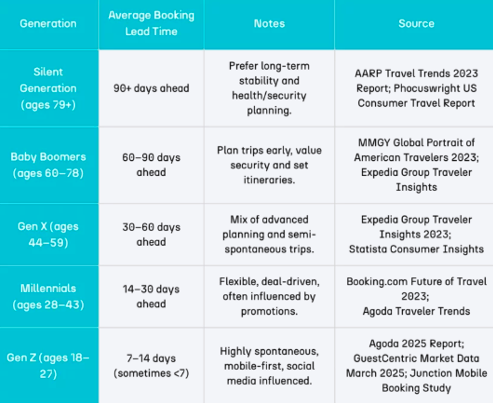In Part 1 of this series, we explored the allure of unscripted travel, the kind that flows like a river, discovering its path as it unfolds. While this approach to travel speaks to the soul of the modern wanderer, it also presents a strategic opportunity for hoteliers. The rise of spontaneous travel, particularly among younger generations, isn’t just a trend. It’s a shift in traveler psychology that calls for an equally fluid commercial response.
Generational Behavior, Commercial Implications
To build a brand for the future, it’s critical to learn how to target Millennials and Gen Z. Research shows these two demographics are significantly more likely to book travel on short notice. Their decisions are often guided less by long-term planning and more by emotion, experience, and the promise of discovery. Compare this to older generations, such as Gen X and Boomers, who still lean toward structured itineraries and advance bookings. Both groups are valuable, but their behavior calls for different strategies.

So how can hotels position themselves to capture the spontaneous traveler while still supporting the planner?
Stay Present in the Moment: Real-Time Visibility Matters
Spontaneous travelers rely heavily on mobile and meta-search platforms to guide last-minute choices. If your hotel isn’t optimized for mobile search, appearing in geo-targeted results, or participating in same-day booking platforms, you’re likely invisible at the moment of decision.
Action Step: Keep tabs on dynamic pricing and invest in rate and inventory management tools that allow for dynamic updates and ensure parity across OTAs and your direct channels, especially for last-minute availability.
Create Packages That Feel Discovered, Not Delivered
Modern spontaneous travelers still appreciate value but don’t want it to feel forced. Flash sales, curated add-ons (think: “Tonight Only: Rooftop Cocktail + Late Checkout”), or local experience bundles can drive conversion when presented as limited, insider offers.
Action Step: Use language that aligns with discovery and exclusivity, “Just for tonight,” “Found this weekend,” or “Hidden gem deal,” instead of traditional package names like “Romance Package” or “Stay & Save.”
But here’s the key: For these offers to feel genuine (and perform well), they need to be opened and closed with intention. A “Just for tonight” rate that’s available every night becomes meaningless. Revenue Managers and Marketers should deploy and remove these offers dynamically, based on real-time demand, pace, and pickup needs, to preserve urgency and impact.
Lean into Local: Curate, Don’t Just Promote
Spontaneous travelers often seek authenticity over attraction. They’re not chasing landmarks; they’re chasing moments. Your hotel’s role is to curate hyper-local and personalized experiences that feel unique to your destination.
Action Step: Highlight neighborhood gems, staff picks, and off-the-beaten-path tips in pre-arrival emails, booking confirmations, or even in your OTA listings. Be the guide, not just the venue.
Note: Whenever you recommend a local business, whether it’s a taco stand, gallery, or bike rental, let them know. This builds goodwill, encourages reciprocal referrals, and helps position your hotel as a connected, community-driven brand. Over time, these relationships can blossom into partnerships, co-promotions, or even exclusive guest perks.
Use Social and SMS to Signal the Unexpected
Social media is a key driver of last-minute bookings. Gen Z travelers, in particular, act on FOMO—if they see others doing it, they’re more likely to jump in. Your content should reflect spontaneity and movement: “book now, arrive tonight,” “look what you’re missing,” “grab your ‘Go’ bag and go.”
Action Step: Integrate dynamic content on Instagram Stories, TikTok, or even SMS marketing that shows live availability, limited-time perks, or behind-the-scenes footage of guest experiences happening now.
Note: SMS Marketing to past guests is a great way to target last-minute travel or specific need periods.
Reward the Repeat Spontaneity
Just because they booked on a whim doesn’t mean they’re one-time guests. In fact, spontaneous travelers who feel emotionally connected to a place are more likely to return. But they need a reason—and a reminder.
Action Step: After checkout, send a personalized “Come Back Soon” offer that rewards their spontaneity. Try messaging like, “Loved your quick escape? Here’s a special offer to come back soon.”
This approach not only shows appreciation but also provides a tangible incentive for guests to return.
Let the Traveler Flow—You Just Have to Catch Them
In a world that no longer moves in straight lines, hotels must think less like static buildings and more like living hosts—ready, responsive, and relevant in the moment. Spontaneous travel isn’t unpredictable; it’s just untraditional. With the right tools and mindset, Revenue Managers and Marketers can meet guests at the bend in the river—and convert inspiration into bookings.


